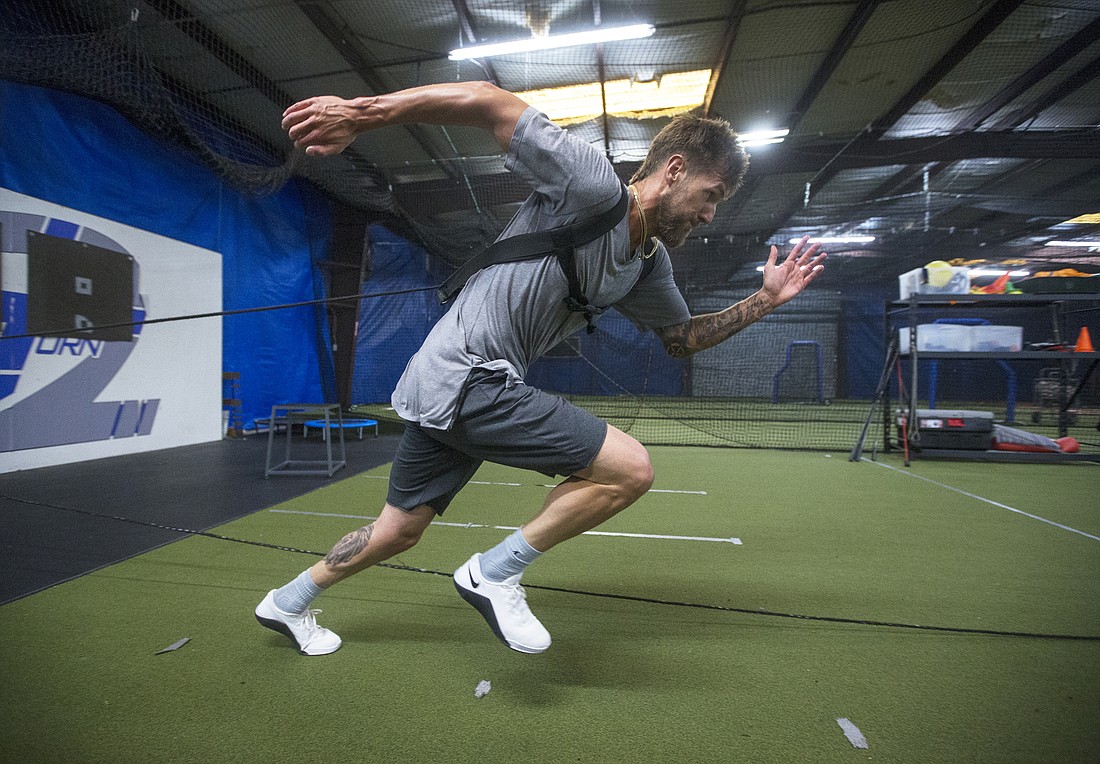- April 19, 2024
-
-
Loading

Loading

The sports fields around the state and country are quiet. The same can be said about the cavernous warehouse that is a part of Turn2 Sports & Performance in Oakland.
The usually busy facility is all but empty, sans Barrett Stover of Revolution Sports Performance and his client, Shane Greene — a Clermont local and relief pitcher for the Atlanta Braves.
With Spring Training canceled, Greene has a lot of time on his hands. He — like other athletes of all levels — finds himself doing his best to keep in shape while the coronavirus keeps the sports world shut down.
“I come here in the mornings, and then somedays, I go to another place that is in Orlando — I’m not training there, but I’m doing body function,” he said. “I can use that space like a training room. And then I go home, and I go fishing. I’m going to be the tannest person that comes out of quarantine.”
For just over two hours, Stover puts Greene through a routine that focuses on his lower body with different running and weight exercises. This is how elite athletes get better, Stover said.
“A lot of it is just being able to finish his rotation in his front leg,” Stover said. “ It’s something that he has felt could possibly get back to — he had a really good year last year — the next level. It’s something his body doesn’t naturally do well, so for someone who is already an elite-level guy, it’s about where you can find that extra one or two percent.”
While Turn2 and Revolution — which work in collaboration — have been doing solely one-on-ones with their most elite athletes, everything else has been shut down.
Instead of seeing familiar faces walking through the front door, it’s been a ghost town.
“It has decimated business,” Turn 2 partner Randy Pundsack said. “We’re in an environment — and in a group-training format — where we like to run hitting sessions with six to eight athletes and one trainer. We’ve communicated with attorneys and insurance companies … to try and find a way to stay open — and not from a profiteering standpoint.
“A majority of our conversation is how can we help these kids — who become accustomed to training every day and look forward to that — expand their potential opportunities to play at the next level,” he said.
Not everyone has access to workout equipment, and with gyms shuttering alongside sports, the challenge for many local athletes is figuring out how exactly to work out at home.
Just before the season was suspended, Stover received numerous phone calls from athletes trying to figure out what to do to stay into shape. His answer was basically, “Do whatever you can.”
Along with the programs Stover offers via virtual workouts, he said there were numerous makeshift ways of staying in shape. He offered suggestions such as simply standing on a towel — pulling up and twisting as a sort of resistance exercise — or filling up a book bag with cans or water bottles to use for squats.
“It’s trying to get as much out of this time period as we can, so guys aren’t just sitting around and doing nothing,” Stover said.
Keeping athletes and people in general moving is the biggest concern for trainers around the area, because it’s easy to get lazy, said Micah Kurtz, director of sports performance at Windermere Prep.
“A majority of our conversation is how can we help these kids — who become accustomed to training every day and look forward to that — expand their potential opportunities to play at the next level.”
— Randy Pundsack, Turn 2 partner
Kurtz has spent most of the time away from campus sharing full-blown workout routines with the school’s student-athletes via social media. He also has received questions from athletes concerned about losing the strength and speed gains picked up in the gym.
“There is some good news from that, where even if they don’t have access to a gym, strength and aerobic capacity generally can last up to 30 days with minimal training,” Kurtz said. “So if they don’t have access to weight room, but they’re still staying active and doing body-weight exercises, they’re really not going to lose their strength gain.
“Speed and power adaptations go away much quicker — those can diminish within five days,” he said. “So I try and talk with them … make sure you’re getting out in your yard or your driveway or an open space, as long as you’re social distancing, go put force into the ground and run sprints and do vertical jumps.”
For an athlete to keep up the pace, Kurtz suggested training four to five days a week — making sure at least two to three involve total-body strength exercises, while the other days focus on speed and agility training.
It’s also important to keep up the effort if you’re an athlete, because it’s a chance to get a leg up on others, Kurtz said.
“There is a lot of good that can come from this kind of chaos, and it’s really a huge window of opportunity that they can potentially separate themselves from their competition,” Kurtz said. “With everybody being thrown off their normal routine and their gyms being closed, a lot of people can potentially get lazy and slack off.”